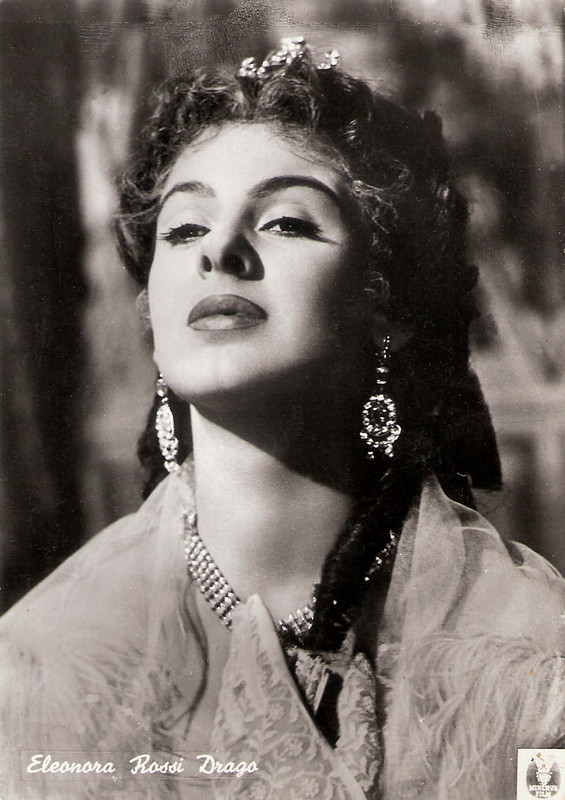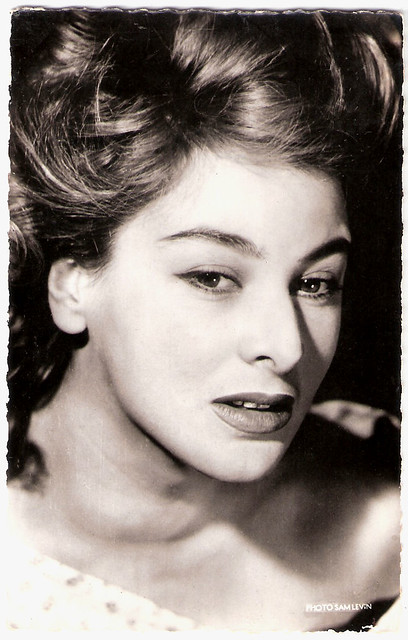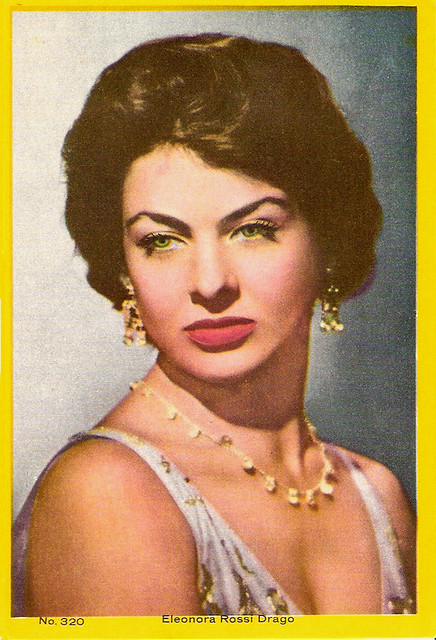Voluptuous, visually stunning Italian film actress Eleonora Rossi Drago (1925–2007) played princesses and temptresses throughout Italian cinema of the 1950s and 1960s. She never found the international cross-over fame destined for Sophia Loren and Gina Lollobrigida, but she earned respect as a fine actress playing leading roles in films by such famous directors as Michelangelo Antonioni, Luigi Comencini and Valerio Zurlini.
![Eleonora Rossi Drago]()
Italian postcard by Bromofoto, Milano, no. 369. Photo: Minerva Film.
![Eleonora Rossi Drago]()
Italian postcard by Rotalfoto, Milano, no. 114.
![Eleonora Rossi Drago]()
Italian postcard by B.F.F. Edit, no. 3329. Photo: ENIC.
Eleonora Rossi Drago was born Palmina Omiccioli near Genoa, Italy, in 1925. She was the daughter of a Spanish sea captain and an Italian mother. At the age of 17, Palmina married to a gentleman named Rossi and bore a daughter, Fiorella. The marriage did not last, and mr. Rossi emigrated to Argentina leaving his wife to raise their daughter by herself. She found work as a department store mannequin and began actually designing couture clothing herself.
An arresting beauty, she started competing in beauty contests and wound up in fourth place in the Miss Italy pageant. Gina Lollobrigida came in third. The attention lured her to films. She moved to Rome and in 1949 began receiving small film roles while using her married name of Rossi.
Her first two big breaks came with Persiane chiuse/Behind Closed Shutters (Luigi Comencini, 1951) with Massimo Girotti, a melodrama about prostitution, and the highly controversial Sensualità/Barefoot Savage (Clemente Fracassi, 1952) in which Marcello Mastroianni and Amedeo Nazzari violently quarrel over her affections.
Persiane chiuse was considered a strong success. The highly impressed director, Luigi Comencini went on to cast Eleonora as a female lead in his next film La tratta delle bianche/The White Slave Trade (Luigi Comencini, 1952), another tawdry melodrama about prostitution that co-starred Vittorio Gassman and also showcased the up-and-coming Sophia Loren.
![Eleonora Rossi Drago]()
Italian postcard by Vetta Traldi, Milano, in the series Divi del Cinema, no. 56.
![Eleonora Rossi Drago]()
German postcard by Filmbilder-Vertrieb Ernst Freihoff, Essen, no. 118. Retail price: 10 Pfg. Photo: Franco London Film.
![Eleonora Rossi Drago]()
French postcard by Editions du Globe, Paris, no. 624. Photo: Sam Lévin.
![Eleonora Rossi Drago]()
French postcard by Editions P.I., Paris, no. 483, presented by Les Carbones Korès, no. 27D.
According to Gary Brumburgh at IMDb,it was obvious that Eleanora Rossi-Drago “had the makings of a bosomy sex goddess but she constantly strove to better her acting reputation in classier material”. She got the nickname of the 'Lady of the Italian Cinema'. In 1954 she appeared opposite Madeleine Robinson in the L'affaire Maurizius/On Trial (Julien Duvivier, 1954), a bleak drama about the miscarriages of justice. In 1955 she won critical notice on stage as Helena opposite Marcello Mastroianni in Anton Chekhov's Uncle Vanya directed by Luchino Visconti.
Her finest hour in the cinema came about that same year with the release of Le amiche/The Girlfriends (Michelangelo Antonioni, 1955). She starred in this rags-to-riches story as a humble girl who becomes a respected owner of a fashion salon. Among her other standout roles in the 1950´s were Kean (Vittorio Gassman, Francesco Rosi, 1956) again opposite Gassman, Suor Letizia/The Awakening (Mario Camerini, 1957) starring Anna Magnani, the Oscar nominated La strada lunga un anno/The Year Long Road (Giuseppe de Santis, 1958) opposite Silvana Pampanini, and the crime drama Un maledetto imbroglio/An Ugly Mess (Pietro Germi, 1959) with Claudia Cardinale.
In the Italian/French co-production Estate violenta/Violent Summer (Valerio Zurlini, 1959), she played a married woman approaching middle age who surrenders herself to a younger man (Jean-Louis Trintignant) during the summer of '43 and the height of fascism. The film earned her the Nastro d'argento(Silver Ribbon award), voted for by Italian film journalists, and the Best Actress award at the Mar del Plata Film Festival in Argentina.
![Eleonora Rossi Drago]()
Italian postcard by Turismofoto, no. 63.
![Eleonora Rossi Drago]()
French postcard by Editions P.I., no. FK 3096. Photo: Joachim G. Jung / Ufa.
![Eleonora Rossi Drago]()
Russian postcard by Izdanije Byuro Propogandy Sovietskogo Kinoiskusstva, no. 21.250, 1961. Retail price: 8 Kop.
Eleanora Rossi Drago was forced to take on provocative roles of lesser quality - roles that usually emphasized her physical attributes or enhanced the scenery around her. While Sophia Loren had a Carlo Ponti to promote her internationally, Rossi-Drago was less fortunate. By the 1960´s she was relegated to such unmemorable adventures, horror films and sword-and-sand spectacles as David e Golia/David and Goliath (Ferdinando Baldi, Richard Pottier, 1960) with Orson Welles playing King Saul, and Rosmunda e Alboino/Sword of the Conqueror (Carlo Campogalliani, 1961) opposite a raping and pillaging Jack Palance.
More interesting were her parts in the anthology film L´amour a vingt ans/Love at Twenty (Renzo Rossellini a.o., 1961), Anima nera/Black Soul (Roberto Rossellini, 1962) and the delightful comedy Se permettete parliamo di donne/Let's Talk About Women (Ettore Scola, 1964) starring Vittorio Gassman. In 1964, she also appeared in the TV mini-series La Cittadella (Anton Giulio Majano, 1964), an adaptation of A. J. Cronin's novel, The Citadel. Elsewhere, she was pretty much overlooked in the epic ensemble as Lot's wife in the mammoth failure The Bible: In the Beginning... (John Huston, 1966).
Things did not improve into the decade and after appearing in the elegant erotic drama Camille 2000 (Radley Metzger, 1969), in the critically-panned retelling of The Picture of Dorian Gray, Das Bildnis des Dorian Gray (Massimo Dallamano, 1970) with Helmut Berger, and in the good-looking giallo thriller Nelle pieghe della carne/In the Folds of the Flesh (Sergio Bergonzelli, 1971) with Pier Angeli, she called it quits.
Blending back inconspicuously into mainstream society, she married Sicilian businessman Domenico La Cavera in 1973, and eventually retired to Palermo, Italy. In 1989 she returned once to the screen, for the documentary Ben Webster: The Brute and the Beautiful (John Jeremy, 1989) about jazz saxophonist Ben Webster. In 2007, Eleanora Rossi Drago died of a brain haemorrhage at the age of 82. She was survived by her second husband and her daughter.
![Eleonora Rossi Drago]()
Mexican card, no. 320.
Scene from Estate violenta/Violent Summer (1959). Source: bolingbroke70 (YouTube).
Sources: Gary Brumburgh (IMDb), Hal Erickson (AllMovie), Wikipedia and IMDb.

Italian postcard by Bromofoto, Milano, no. 369. Photo: Minerva Film.

Italian postcard by Rotalfoto, Milano, no. 114.

Italian postcard by B.F.F. Edit, no. 3329. Photo: ENIC.
An Arresting Beauty
Eleonora Rossi Drago was born Palmina Omiccioli near Genoa, Italy, in 1925. She was the daughter of a Spanish sea captain and an Italian mother. At the age of 17, Palmina married to a gentleman named Rossi and bore a daughter, Fiorella. The marriage did not last, and mr. Rossi emigrated to Argentina leaving his wife to raise their daughter by herself. She found work as a department store mannequin and began actually designing couture clothing herself.
An arresting beauty, she started competing in beauty contests and wound up in fourth place in the Miss Italy pageant. Gina Lollobrigida came in third. The attention lured her to films. She moved to Rome and in 1949 began receiving small film roles while using her married name of Rossi.
Her first two big breaks came with Persiane chiuse/Behind Closed Shutters (Luigi Comencini, 1951) with Massimo Girotti, a melodrama about prostitution, and the highly controversial Sensualità/Barefoot Savage (Clemente Fracassi, 1952) in which Marcello Mastroianni and Amedeo Nazzari violently quarrel over her affections.
Persiane chiuse was considered a strong success. The highly impressed director, Luigi Comencini went on to cast Eleonora as a female lead in his next film La tratta delle bianche/The White Slave Trade (Luigi Comencini, 1952), another tawdry melodrama about prostitution that co-starred Vittorio Gassman and also showcased the up-and-coming Sophia Loren.

Italian postcard by Vetta Traldi, Milano, in the series Divi del Cinema, no. 56.

German postcard by Filmbilder-Vertrieb Ernst Freihoff, Essen, no. 118. Retail price: 10 Pfg. Photo: Franco London Film.

French postcard by Editions du Globe, Paris, no. 624. Photo: Sam Lévin.

French postcard by Editions P.I., Paris, no. 483, presented by Les Carbones Korès, no. 27D.
Lady of the Italian Cinema
According to Gary Brumburgh at IMDb,it was obvious that Eleanora Rossi-Drago “had the makings of a bosomy sex goddess but she constantly strove to better her acting reputation in classier material”. She got the nickname of the 'Lady of the Italian Cinema'. In 1954 she appeared opposite Madeleine Robinson in the L'affaire Maurizius/On Trial (Julien Duvivier, 1954), a bleak drama about the miscarriages of justice. In 1955 she won critical notice on stage as Helena opposite Marcello Mastroianni in Anton Chekhov's Uncle Vanya directed by Luchino Visconti.
Her finest hour in the cinema came about that same year with the release of Le amiche/The Girlfriends (Michelangelo Antonioni, 1955). She starred in this rags-to-riches story as a humble girl who becomes a respected owner of a fashion salon. Among her other standout roles in the 1950´s were Kean (Vittorio Gassman, Francesco Rosi, 1956) again opposite Gassman, Suor Letizia/The Awakening (Mario Camerini, 1957) starring Anna Magnani, the Oscar nominated La strada lunga un anno/The Year Long Road (Giuseppe de Santis, 1958) opposite Silvana Pampanini, and the crime drama Un maledetto imbroglio/An Ugly Mess (Pietro Germi, 1959) with Claudia Cardinale.
In the Italian/French co-production Estate violenta/Violent Summer (Valerio Zurlini, 1959), she played a married woman approaching middle age who surrenders herself to a younger man (Jean-Louis Trintignant) during the summer of '43 and the height of fascism. The film earned her the Nastro d'argento(Silver Ribbon award), voted for by Italian film journalists, and the Best Actress award at the Mar del Plata Film Festival in Argentina.

Italian postcard by Turismofoto, no. 63.

French postcard by Editions P.I., no. FK 3096. Photo: Joachim G. Jung / Ufa.

Russian postcard by Izdanije Byuro Propogandy Sovietskogo Kinoiskusstva, no. 21.250, 1961. Retail price: 8 Kop.
Blending Back Inconspicuously
Eleanora Rossi Drago was forced to take on provocative roles of lesser quality - roles that usually emphasized her physical attributes or enhanced the scenery around her. While Sophia Loren had a Carlo Ponti to promote her internationally, Rossi-Drago was less fortunate. By the 1960´s she was relegated to such unmemorable adventures, horror films and sword-and-sand spectacles as David e Golia/David and Goliath (Ferdinando Baldi, Richard Pottier, 1960) with Orson Welles playing King Saul, and Rosmunda e Alboino/Sword of the Conqueror (Carlo Campogalliani, 1961) opposite a raping and pillaging Jack Palance.
More interesting were her parts in the anthology film L´amour a vingt ans/Love at Twenty (Renzo Rossellini a.o., 1961), Anima nera/Black Soul (Roberto Rossellini, 1962) and the delightful comedy Se permettete parliamo di donne/Let's Talk About Women (Ettore Scola, 1964) starring Vittorio Gassman. In 1964, she also appeared in the TV mini-series La Cittadella (Anton Giulio Majano, 1964), an adaptation of A. J. Cronin's novel, The Citadel. Elsewhere, she was pretty much overlooked in the epic ensemble as Lot's wife in the mammoth failure The Bible: In the Beginning... (John Huston, 1966).
Things did not improve into the decade and after appearing in the elegant erotic drama Camille 2000 (Radley Metzger, 1969), in the critically-panned retelling of The Picture of Dorian Gray, Das Bildnis des Dorian Gray (Massimo Dallamano, 1970) with Helmut Berger, and in the good-looking giallo thriller Nelle pieghe della carne/In the Folds of the Flesh (Sergio Bergonzelli, 1971) with Pier Angeli, she called it quits.
Blending back inconspicuously into mainstream society, she married Sicilian businessman Domenico La Cavera in 1973, and eventually retired to Palermo, Italy. In 1989 she returned once to the screen, for the documentary Ben Webster: The Brute and the Beautiful (John Jeremy, 1989) about jazz saxophonist Ben Webster. In 2007, Eleanora Rossi Drago died of a brain haemorrhage at the age of 82. She was survived by her second husband and her daughter.

Mexican card, no. 320.
Scene from Estate violenta/Violent Summer (1959). Source: bolingbroke70 (YouTube).
Sources: Gary Brumburgh (IMDb), Hal Erickson (AllMovie), Wikipedia and IMDb.